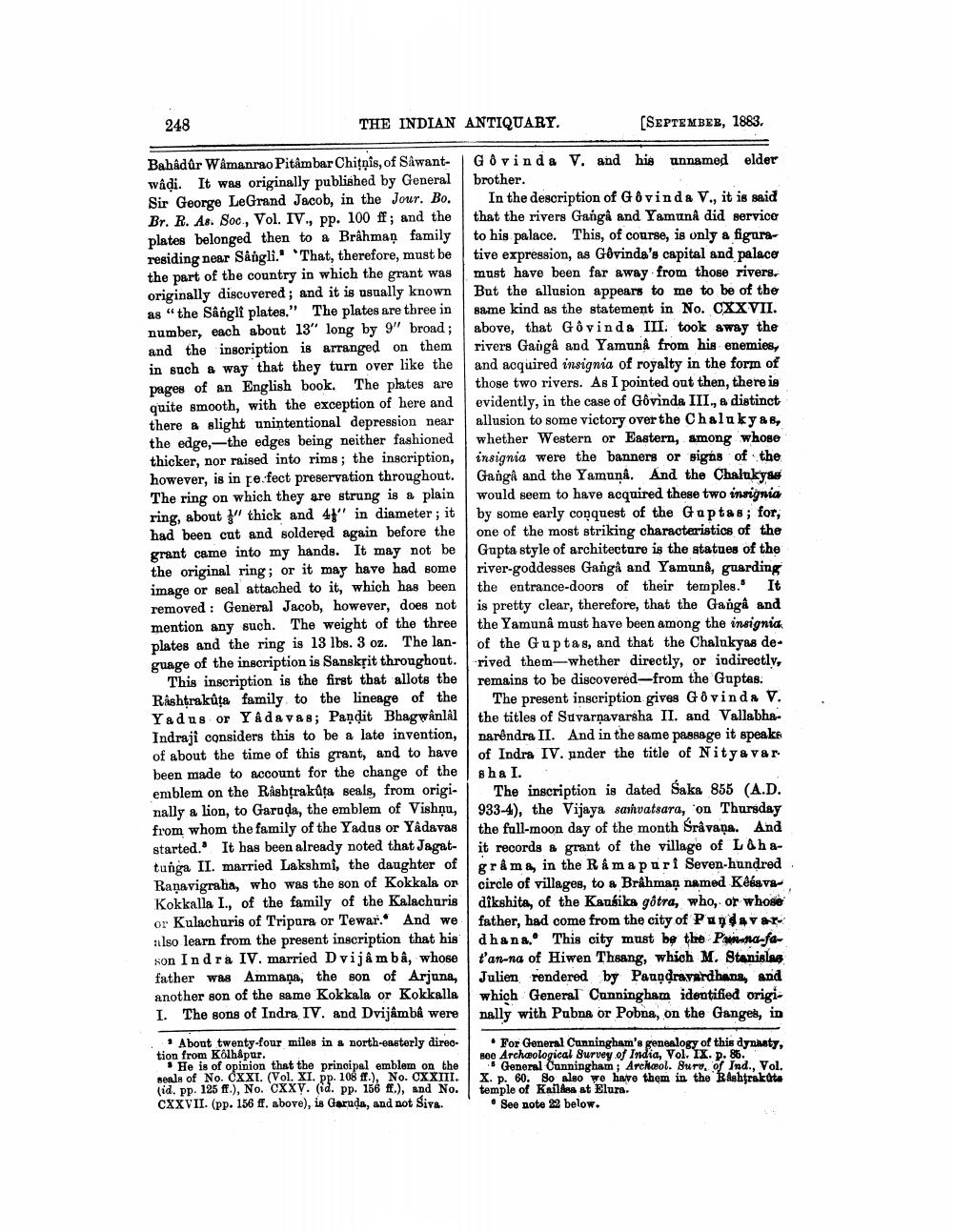________________
248
THE INDIAN ANTIQUARY.
(SEPTEMBER, 1883.
Bahadur W Amanrao Pitambar Chitnis, of Sawant- Gô vinda V. and his unnamed elder wadi. It was originally published by General brother. Sir George LeGrand Jacob, in the Jour. Bo. In the description of Govinda V., it is said Br. R. As. Soc., Vol. IV., pp. 100 ff; and the that the rivers Ganga and Yamuna did service plates belonged then to a Brahman family to his palace. This, of course, is only a figuraresiding near Sangli." That, therefore, must be tive expression, as Govinda's capital and palace the part of the country in which the grant was must have been far away from those rivers. originally discovered ; and it is usually known But the sllusion appears to me to be of the as “the Sangli plates." The plates are three in same kind as the statement in No. CXXVII. number, each about 13" long by 9" broad; above, that Gôvinda III. took away the and the inscription is arranged on them rivers Gaiga and Yamunâ from his enemies, in such a way that they turn over like the and acquired insignia of royalty in the form of pages of an English book. The plates are those two rivers. As I pointed out then, there is quite smooth, with the exception of here and evidently, in the case of Govinda III., a distinct there a slight unintentional depression near allusion to some victory over the Chaluky&B, the edge,-the edges being neither fashioned whether Western or Eastern, among whose thicker, nor raised into rims; the inscription, insignia were the banners or signs of the however, is in re,fect preservation throughout. Ganga and the Yamuna. And the Chalukyse The ring on which they are strung is a plain would seem to have acquired these two insignia ring, about " thick and 41" in diameter; it by some early conquest of the Guptas; for, had been cut and soldered again before the one of the most striking characteristics of the grant came into my hands. It may not be Gupta style of architecture is the statues of the the original ring; or it may have had some river-goddesses Ganga and Yamuna, guarding image or seal attached to it, which has been the entrance-doors of their temples. It removed : General Jacob, however, does not is pretty clear, therefore, that the Gangå and mention any such. The weight of the three the Yamunâ must have been among the insignia, plates and the ring is 13 lbs. 3 oz. The lan- of the Guptas, and that the Chalukyas deguage of the inscription is Sanskrit throughout. rived them-whether directly, or indirectly,
This inscription is the first that allots the remains to be discovered from the Guptas. Rashtrakůta family to the lineage of the The present inscription gives Govinda V. Yadus or Yâda vas; Pandit Bhagwânlål the titles of Savarņavarsha II. and VallabhsIndraji considers this to be a late invention, narendra II. And in the same passage it speaks of about the time of this grant, and to have of Indra IV. under the title of Nitya var been made to account for the change of the shaI. emblem on the Rashtrakata seals, from origi- | The inscription is dated Saks 855 (A.D. nally a lion, to Garoda, the emblem of Vishnu, 933-4), the Vijaya samvatsara, on Thursday from whom the family of the Yadus or Yâdavas the full-moon day of the month Sravana. And started. It has been already noted that Jagat- it records & grant of the village of Lahatunga II. married Lakshmi, the daughter of grâms, in the Ramapuri Seven-hundred Ranavigraha, who was the son of Kokkala or circle of villages, to a Brahman named KekavaKokkalla I., of the family of the Kalachuris dîkshita, of the Kansika gôtra, who, or whose or Kulachuris of Tripura or Tewar. And we father, had come from the city of Pay davar also learn from the present inscription that his dhana. This city must be the Pwna-fason Indra IV. married D vijâmbâ, whose t'an-na of Hiwen Theang, which M. Stanislas father was Ammaņa, the son of Arjuna, Julien rendered by Pauņdravardhana, and another son of the same Kokkala or Kokkalla which General Cunningham identified origiI. The sons of Indra IV. and Dvijâmbâ were nally with Pubna or Pobna, on the Ganges, in
* About twenty-four miles in a north-easterly direo- • For General Cunningham's genealogy of this dynasty, tion from Kolhapur.
Bee Archæological Survey of India, Vol. IX. p. 86. He is of opinion that the principal emblem on the - General Cunningham Archeol. Sury. of Ind., Vol. seals of No. xxl. (Vol. XI. pp. 108 ff.), No. CXXIII. | X. p. 60. So also we have them in the Ashtrakata (id. pp. 125 ff.), No. cxxy. (id. pp. 156 ff.), and No. temple of Kailasa at Elura. CXXVII. (pp. 156 ff. above), is Garuda, and not Siva. • See note 22 below.




